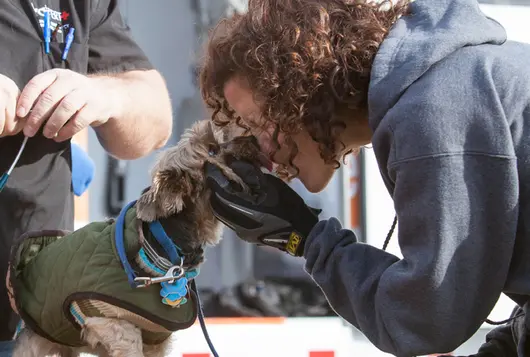3 Tips for Setting Up a Temporary Shelter

In the event of a natural disaster or large-scale criminal case, it’s important to know how to create a temporary animal shelter.
The logistics of setting up and running a temporary shelter can seem overwhelming, but the ASPCA National Field Response (NFR) and Cruelty Recovery Center (CRC) teams have it down to a science. Here, they share the basics on where to establish safe, short-term housing for displaced or seized animals and tips on who should staff the facility.
Where Should the Shelter Be?
With wide open spaces, large loading bays, concrete floors and flexible zoning regulations, warehouses work well for temporary housing. To find one that fits your needs, Jasmine Holsinger, NFR’s Shelter Manager, recommends consulting with a local commercial Realtor.
If you don’t want to reveal all details about the shelter’s uses, she suggests telling the real estate agent that you are conducting a training and animals will be involved.
Besides warehouses, fairgrounds or tents can work in a pinch if weather allows.
Here are other elements to consider when choosing a location:
- Proximity to resources such as groceries, pet supplies and housing for responders
- Proximity to transportation, including highways and airports
- Distance from the affected animals – you want to transport them as short a distance as possible
- Security – this can be especially important in criminal cases
Who Should Be Involved?
Temporary shelters require a lot of people to make them run smoothly. Joe Hinkle, the CRC’s Senior Director of Operations, says that a good rule of thumb is to have one person for every 10 animals. And, to be safe, always plan for double the number of animals you think you might have.
In general, your helpers will fall into three categories:
- Medical personnel. This includes veterinarians and veterinary technicians. Having a veterinarian with shelter medicine experience who is familiar with the concept of herd health is ideal. However, keep in mind that unless a state of emergency has been declared by the President of the United States or the governor of the affected state, only veterinarians who are licensed in that state may provide medical services.
- Sheltering personnel. This includes experienced animal handlers and managers, as well as volunteers with limited training. At a minimum, each animal will require 15 minutes each day for basic feeding and cleaning. Ideally, you will have dedicated logistics and supply chain staff as well as people who are focusing on reunification and placement of the animals.
- Animal behavior personnel. This includes animal behaviorists, behavior experts, animal trainers who can oversee behavioral health monitoring and assessment, the development and implementation of enrichment programs, low-stress handling, and any behavior modification to prepare animals for adoption. Incorporating specially trained volunteers can assist with maintaining animals’ psychological health.
All three types of personnel will work together to ensure the overall health, safety and well-being of the animals. In order to do that, excellent communication and the use of communication tools are critical. For example, staff at the ASPCA's CRC recommend using a whiteboard or other accessible spot where staff and volunteers can record any medical issues they are seeing with a particular animal. The board will allow medical personnel to hone in on animals most in need when they are making their rounds.
Temporary shelter staff can come from any of these groups:
- Regular shelter staff and consultants
- Partner agencies (other shelters, animal controls or disaster teams)
- Volunteers
- Temporary paid labor
“As long as you have strong management and protocols in place, utilizing inexperienced but motivated staff and volunteers works well,” says Mary Sarah Fairweather, Vice President of the CRC.
How Should It Be Organized?
You will need plenty of space to accommodate all the functions your temporary shelter must serve, including the following:
- Intake. This should be a separate area for all incoming animals. In the case of a disaster, it should be clearly labeled so it’s easy to find by people temporarily dropping off their animals.
- Housing & enrichment. Ideally, you should have housing for three separate groups of animals: general population, animals in isolation, and pregnant or nursing mothers and their babies. The CRC team recommends dividing animals into pods of more manageable sizes. These pods should have dedicated staff and supplies to make disease management easier. They should also have their own enrichment areas that are not shared with animals from other pods.
- Office and storage space. Staff will need space to do paperwork and make phone calls, and areas will need to be set aside for storing both office and pet supplies.
We have lots more on this subject:




